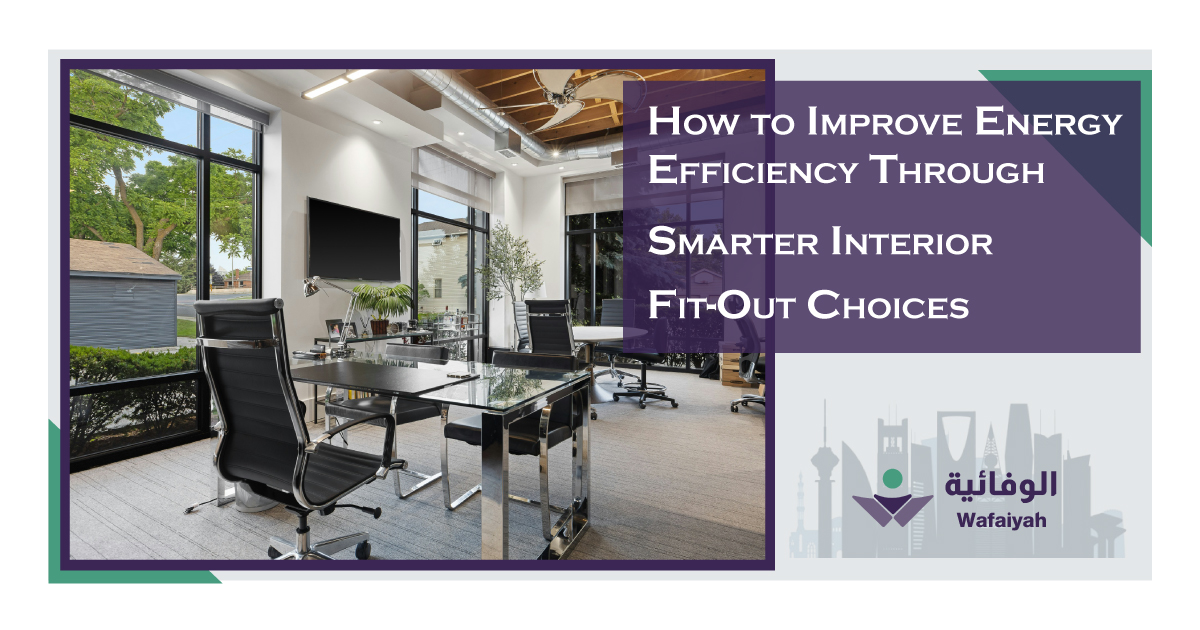In today’s generation, energy efficiency is more important than ever. Rising costs and growing environmental issues are forcing businesses to make smarter choices. One central area that many of us overlook is the role of interior fit-outs. Smart fit-out decisions can have a lasting impact on a building’s energy performance, from lighting and insulation to space planning. This guide shares practical strategies to help designers and decision-makers create energy-efficient spaces. Wafaiyah believes that smart, sustainable fit-outs are not only possible but they are also essential for a better future.
Energy efficiency in interior fit-outs plays a key role in creating sustainable, cost-effective spaces. It involves using smart design, energy-saving materials, and excellent systems like LED lighting and HVAC. Proper planning helps to reduce power use while improving comfort and functionality.
Natural light and proper insulation support long-term savings. By focusing on efficiency from the start, businesses can lower utility costs and reduce their carbon footprint. It also boosts indoor well-being, showing a commitment to a greener future. A well-planned fit-out balances style, function, and sustainability, making it a smart choice for modern commercial interiors.
Starting with a clear plan is key to achieving smart-efficient design. Early interaction between architects, engineers, and eco-friendly consultants ensures that all ideas are aligned from day one. When everyone is on the same page, the project flows better and goals are met more easily.
Using energy modelling and simulations during the design phase helps identify the best systems and materials before construction begins. This reduces costly changes later and improves long-term performance.
A smart fit-out strategy should also support the project’s green building goals. Aligning with certifications like LEED, WELL, or BREEAM not only adds value but also shows commitment to sustainability. Early planning creates buildings that perform better, save more energy, and offer a healthier space for everyone who uses them.
Focusing on Smart Lighting Design Choices
When we talk about adopting smart lighting choices, you should:
- Maximize Natural Daylighting
- Use LED and Sensors
- Install Dimmers and Harvesters
- Implement Zoning Controls
Smart lighting design improves performance and comfort. Focusing on natural daylighting reduces the need for artificial lighting during daylight hours, cutting power costs and enhancing well-being.
LED lights with motion sensors ensure lighting is only active when needed. Choosing between task lighting and ambient lighting allows for more illumination measures. Dimmable lights with daylight systems automatically adjust brightness based on natural light levels, maintaining optimal light without overuse.
Zoning controls, whether by occupancy or area usage, allow precise control of lighting needs in different parts of a building. This helps in improving performance while reducing waste. These choices contribute to sustainable, adaptable, and user-friendly lighting environments.
Common Material Options for Energy Performance
Thermal Mass Materials
Materials like stone, brick, and concrete store heat during the day and release it slowly at night. This helps keep indoor temperatures stable and reduces the need for heating or cooling. They are especially useful in areas with significant temperature changes between day and night.
Insulated Walls and Ceilings
Using insulated panels in walls and ceilings helps keep warm or cool air inside. These panels improve efficiency by reducing heat loss or gain. They also make buildings more comfortable and lower bills by easing the load on heating and cooling systems.
Insulating Flooring Options
Eco-friendly floors like cork, bamboo, and wool carpet help insulate your home. They keep warmth in during winter and coolness in summer. These materials are renewable and low-impact, making them both a green and energy-saving choice for modern buildings and homes.
Cool and Safe Finishes
Low-VOC paints and coatings are safer to breathe and better for health. Using light colours and reflective surfaces keeps buildings cooler by bouncing sunlight away. These finishes improve comfort indoors and reduce the need for air conditioning, especially in warm climates.
Use Local, Green Materials
Choosing local and eco-friendly materials cuts down on pollution from transport. It also supports nearby businesses. Local materials often match the climate better and last longer, while also reducing the building’s overall environmental impact and helping save power over time.
Future of Smart Technology for Energy Efficient Interiors
The future of interior spaces is being reshaped using smart technology within power efficiency. As homes and offices evolve, smart systems are becoming essential for reducing waste while improving comfort and convenience. Automated lighting, climate control, and smart appliances can now understand user behaviour and adjust settings in real time. This results in lower energy bills and a reduced carbon footprint.
Modern smart interiors also handle sensors, AI-powered controls, and remote access through mobile apps. These features allow users to manage their power usage better, even when they are away. For example, smart thermostats can adjust temperatures based on occupancy and weather forecasts. This helps in saving power without compromising comfort.
Energy-efficient interiors also support sustainable living. With better data insights and control, users can make smarter decisions every day. Businesses, too, benefit from reduced operational costs and improved power ratings.
Looking ahead, the combination of smart design and eco-conscious technology will continue to grow. As innovation becomes more affordable and accessible, smart interiors will become the new standard. The goal is clear, comfortable, connected, and sustainable spaces that work in harmony with the environment. This is not just a trend; it is the future of how we live and work.
Conclusion
Smarter fit-out choices play a key role in improving long-term power performance. From layout to materials, every decision helps in creating a more sustainable space. This is the right time for businesses to take a closer look at their own fit-out plans and consider where improvements can be made. Wafaiyah supports thoughtful design that balances function and responsibility. After all, energy efficiency isn’t just a nice-to-have, it’s a shared responsibility we all carry for the future.
Frequently Asked Questions
1. What is the most energy-efficient lighting choice for interior fit-outs?
LED lighting with occupancy sensors and dimming features offers the best balance between efficiency and user comfort.
2. How do interior materials affect a building’s energy use?
Materials with good thermal properties can reduce heating and cooling loads by maintaining internal temperature stability.
3. Can energy-efficient fit-outs be cost-effective?
Yes, while initial costs might be slightly higher, the long-term savings on utility bills and maintenance can outweigh them significantly.
4. Is smart technology necessary for energy-efficient interiors?
Not always—but smart systems optimize performance and provide real-time insights that make ongoing power savings easier to achieve.

